Frequently Asked Questions
General questions
How long do teachers stay with your company?
Our teachers usually stay on staff for one or two years. Our goal — especially in kindergarten and grades 1-4 — is to have the same native teacher stay with the students for as long as possible. Consequently, we aim to hire more resident native teachers who are based in Hungary long term. On the other hand, having different teachers has also proven to have a positive effect, as students will be exposed to a variety of dialects, leading to better understanding of native English speakers from all over the world.
Is the Bilingual Program the same as the Szőlőtő Alapítvány program?
Our operation is completely independent of Szőlőtő Alapítvány (“Foundation”), from whom we have purchased the exclusive license for the bilingual education program. Years of experience with the program helped identify areas that needed improvement: more emphasis on use of English and writing, the addition of a literature component, the Reading Program, to the curriculum at each grade level in order to develop reading comprehension; digitals skills development in the Going Digital program). These changes have been implemented from 2014, resulting in more complex competency levels for our students, with particular respect to culture.
What makes the Bilingual Program different or special compared to other bilingual programs?
Our primary school program, just like our kindergarten program, emphasizes immersion principles as extensively as possible, especially in grades 1 to 6. Because English language – and to some extent, culture – are incorporated into nearly all activities, classes and topics, children continue to learn a good deal of their English incidentally, in the same way they acquire their native language. In this regard, the teachers’ presence outside of lesson times – before first period begins, during breaks, and during meal times – is a vitally important added value of the program, particularly in grades 1 to 4.
Another distinctive element of the Bilingual Program at all levels is our use of the one-person/one-language model of co-teaching, sometimes called the bilingual family model. The approach is straightforward: the Hungarian co-teacher speaks only Hungarian, and the Bilingual teacher – a native speaker of English, or on occasion a balanced bilingual – speaks only English. Moreover, our teachers do not evince any understanding of Hungarian, even passively. This allows us to maximize the language immersion and language learning opportunities of the students in the Bilingual Program.
Our goal is the delivery of a bilingual education program that takes into account the demands of the Hungarian national curriculum and the course of events in a student’s life as they move through the Hungarian education system.
How does co-teaching work?
The Hungarian co-teacher speaks only Hungarian and the Bilingual teacher – a native speaker of English or on occasion a balanced bilingual – speaks only English.
Co-teaching is the rule of the day in all subject classes, where we adhere to our one-person, one-language rule, offering ample opportunity to the children for code-switching through frequent shifts in focus from teacher to teacher, all with an even distribution of time in each language.
Are English lessons co-taught? What about Hungarian lessons?
The Bilingual Program features most subjects in co-taught or English only lessons (except Ethics and, of course, Hungarian Language and Literature). Some of the lessons of a few subjects are not co-taught (e.g. PE 3 out of 5 are co-taught, 2 are Hungarian) In grades 7-8 subjects of science are taught in the form of science tutorials. Students have an only-English lesson every day.
In English classes, in most cases we split the class into two similarly-sized, mixed-ability groups, with one cohort heading to another classroom for that day’s lesson. One split group remains with one teacher for the entire week; the following week, teachers switch groups. Thus students spend an equal amount of time with each teacher over the course of the year. They speak English throughout English language lessons.
Tutorials (small group sessions of 4-8 students) are another key feature of the Bilingual Program. These are mandatory 30-minute sessions in the afternoon. In contrast to the split groups for English lessons, tutorial groupings are often based on language level. In general, these small group sessions provide the perfect opportunity for reading development as well as further communicative practice and test review.
What level of English will students achieve by the end of 8th grade? What kind of language exams will they be prepared for?
The Cambridge English Language Testing System is acknowledged and used worldwide for language competency assessment, and is regarded as the most comprehensively designed system of testing available. By 8th grade, we expect our students to be prepared to take the FCE for Schools test. In addition, we use in-house tests to track the development of language competency as per Cambridge system standards.
Why does the Bilingual Program bring children to a higher level compared to other bilingual programs?
A distinctive element of the Bilingual Program at all levels is our use of the one-person/one-language model of co-teaching, sometimes called the bilingual family model. The approach is straightforward: the Hungarian co-teacher speaks only Hungarian and the Bilingual teacher – a native speaker of English or on occasion a balanced bilingual – speaks only English. Moreover, our teachers do not evince any understanding of Hungarian, even passively. This allows us to maximize the language immersion and language learning opportunities of the students in our program.
The methodology we use – what gets the job done – remains, in its essence, the same throughout the entirety of our program. We employ the techniques and insights of TEFL (Teaching English as a Foreign Language) combined with the logic and strategies of CLIL (Content and Language Integrated Learning) to develop young people who can speak, read and write English with a great deal of confidence, young people who are years ahead of their peers, young people who are able to go abroad to study, travel, and eventually work – all without missing a heartbeat.
Results so far have shown that our graduates’ English communication skills are much more advanced than those of graduates from other bilingual programs, and without compromising subject competency, which is often also outstanding.
How do you benchmark students’ performance?
Bilingual uses the Cambridge English Language Testing System in order to externally benchmark the performance of its students. It is the premier provider of English language exams for speakers of other languages globally, with meticulously well-prepared exams and preparation material for learners of all ages (from as young as seven or eight years old up through adulthood). There is no better way to measure the success of a bilingual education program than through these assessment tools.
Are there bilingual textbooks for every subject?
Students follow the Hungarian curriculum and use a textbook chosen by the Hungarian teacher. Based on joint planning sessions, the native English-speaking co-teacher prepares appropriate English-language course materials for each lesson using a variety of previously compiled course materials, English-language textbooks, and online resources. These handouts are added to students’ notebooks or course folders. There are a few textbooks for subjects (with a grade by grade difference).
Do the students have difficulty learning grammar in English?
Because English language – and to some extent, culture – are incorporated into nearly all activities, classes and topics, children continue to learn a good deal of their English incidentally, in the same way they acquire their native language. In this regard, the teachers’ presence outside of lesson times – before first period begins, during breaks, and during mealtimes – is a vitally important added value of the program, particularly in grades 1 to 4.
Beginning in first grade, and especially from third grade on, students broaden the ways in which they acquire their English. Focused and sustained study of lexical items begins in first grade, reading and writing in English begins at the end of first grade but begins in earnest at the start of second grade (so as not to interfere with the children’s acquisition of knowledge and skills in Hungarian), and English grammatical structures are introduced in increasingly explicit ways from third grade onwards.
In 8th grade, most of our students successfully pass the Cambridge FCE for Schools B2 level mock exam administered by the British Council in our partner institutions, in a very similar environment compared to the official exam. In order to develop difficult elements for most students, such as use of English and writing, two years of goal-oriented, mandatory exam preparation lessons are provided, starting in 7th grade as well as two years of mandatory afternoon tutorials
Where are your teachers from?
Most of our teachers are from native English-speaking countries, such as the U.S. or Great Britain, but there are South-African, Canadian, and Australian staff members among them as well.
Where are your teachers from?
Most of our teachers are from native English-speaking countries, such as the U.S. or Great Britain, but there are South-African, Canadian, and Australian staff members among them as well.
Are your teachers native speakers of English?
Bilingual considers it critical to employ only teachers who are native speakers of English or, on occasion, balanced bilinguals.
What qualifications do your teachers have?
Our teachers may be specialized in Teaching English as a Foreign Language, or in Primary or Secondary Education, and in many cases both. Our Upper Primary and Secondary teachers are also subject-specialized. During their orientation they also receive training in our special methodology. This range of background, training, and experience allows our staff to employ the full range of approaches and techniques on which the success of the Bilingual Program is based.
How long do teachers stay with your company?
Our teachers usually stay on staff for one or two years. Our goal — especially in kindergarten and grades 1-4 — is to have the same native teacher stay with the students for as long as possible. Consequently, we aim to hire more resident native teachers who are based in Hungary long term. On the other hand, having different teachers has also proven to have a positive effect, as students will be exposed to a variety of dialects, leading to better understanding of native English speakers from all over the world.
Do your teachers speak Hungarian?
The Bilingual teacher – a native speaker of English or on occasion a balanced bilingual – speaks only English within the program. Moreover, our teachers do not evince any understanding of Hungarian, even passively. This allows us to maximize the language immersion and language learning opportunities of the students in our program.
Do your teachers speak Hungarian with the students?
No. In our program, we stick to the one-person/one-language model for the best language learning results.
Can we see a lesson?
Yes. Every year, we hold a number of “open days” at each partner institution, with a variety of lessons open to pre-registered visitors. You can find information about open days at the Contact/Enrollment section.
Does my child need to be exceptionally gifted (at languages or otherwise) in order to participate in the program?
We do recognize that the Bilingual Program may not be suitable for all children as the demands of the Hungarian curriculum increase over the years. If the child has development issues in their native language, we do not recommend this program. However, resulting from our special methodology, our teachers try to make the lessons and learning in general as playful and enjoyable as possible.
Can my child join the Bilingual Program if he/she’s a beginner? If he/she’s never studied English before?
In our experience, children who acquire a language base in our kindergarten program do better in the primary school program. For children from non-bilingual kindergarten programs, we offer an English preparatory program (on demand).
Children in 2nd or 3rd grade who are complete beginners can only be admitted into the program if they are exceptionally motivated to learn the language. In such cases, remedial English courses outside the curriculum must be arranged by the family.
In higher grades, beginners are not recommended to enter the program because it is highly unlikely that they would be able to catch up.
Do the parents have to be able to speak English?
No, but it is useful, especially in the first period.
Can students continue the program in secondary school?
Yes, at our High School Program
Frequently asked questions regarding billing
What to do if you do not receive the invoice notification e-mail (or other e-mail sent by Számlázz.hu) in your (Gmail) inbox.
When you use Gmail, account notification (and other) emails land in your inbox, also under the Primary tab.
If the recipient cannot find the letter there, please first check it in the same place (Inbox) under the Promotions tab. If you have the letter there, you can drag it under the Primary tab with your mouse. As a result, Gmail learns that these emails aren’t business offers, so they’re in place under the Primary tab.
The third place where lost mail can be found is the Spam folder. If the e-mail from Számlázz.hu is here, you should click on the NOT SPAM button. This will teach Gmail that Számlázz.hu will never send spam.The most recent update from számlázz.hu:
If your partner uses an Outlook-based e-mail system, unfortunately, even though the email has been sent successfully, they may not receive the invoice because their email provider blocks our mail.
Unfortunately, this is a global issue, and we have contacted the service provider to resolve it. However, your partners may not receive notifications for an indefinite period of time.
We recommend using a different email address temporarily.
What is a customer account?
A customer account allows our customers to see all the invoices issued to them at once. On this page it is possible to review and download the invoices. Invoices of the Bilingual Program cannot be paid by credit card for the time being (despite the fact that the Számlázz.hu account would be suitable for this).
The customer account is activated by default, so in the invoice notifications, the customer receives a link that they can click to view the invoices issued to them immediately.
If your customer does not get to the customer’s account by clicking on the link in the invoice notification but sees a login screen, it is because they also have a #profi Számlázz.hu account. That is, direct invoicing took place, i.e., the invoice remained within the system. In this case, instead of the in the customer account, the customer will find the given invoice in their own billing account, among the incoming invoices.
What does a customer account look like?
You can see the following in the invoice notification email sent by számlázz.hu.
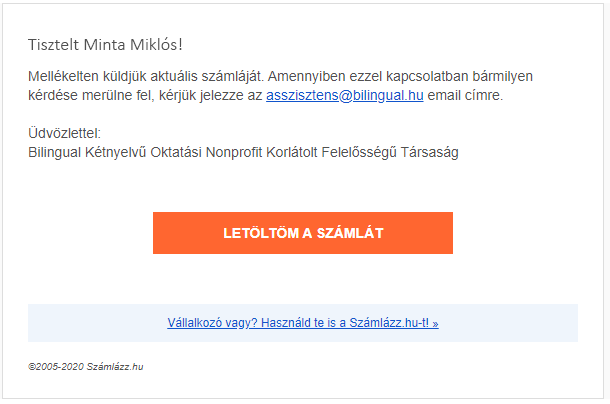
Clicking on “download invoice” “letöltöm a számlát “ (the orange box in the middle of the screen) will show the main details of the invoice, the account number, the payment deadline (in how many days it is due) and the amount to be paid, as well as the data required for the bank transfer (bank account number).
Számla adatai ( means: Account details )
Hogyan szeretné kifizetni ( means: How do you want to pay )
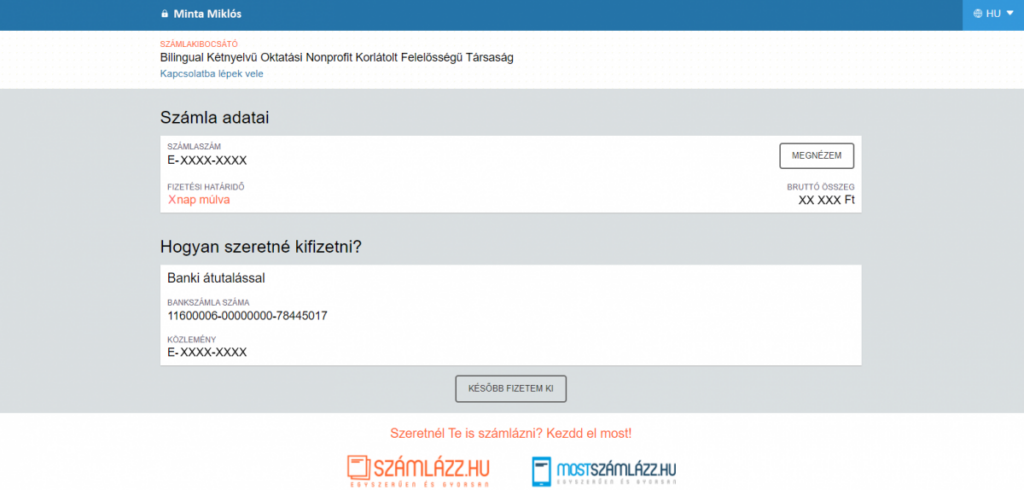
Then you can proceed in two directions: you can open the account image by clicking the view (“ Megnézem “) button.
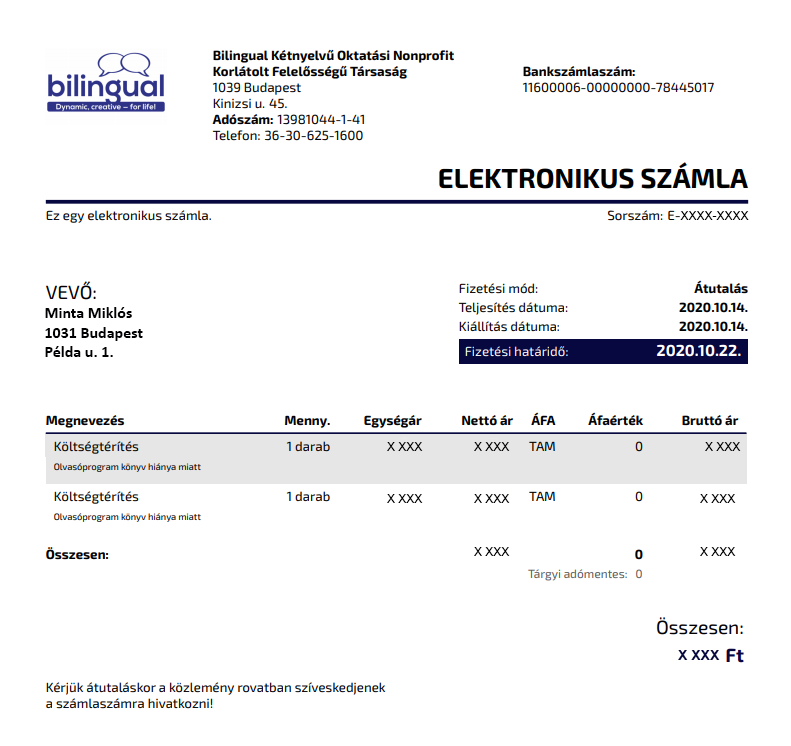
If the invoice has not yet been paid, at the bottom of the previous page, there is a button in the middle (see the previous print screen) that says “I will pay later” (Később fizetem ki) – this is a very misleading and, unfortunately, unchangeable text. If the invoice has been paid , click the text (as shown in the screen below)
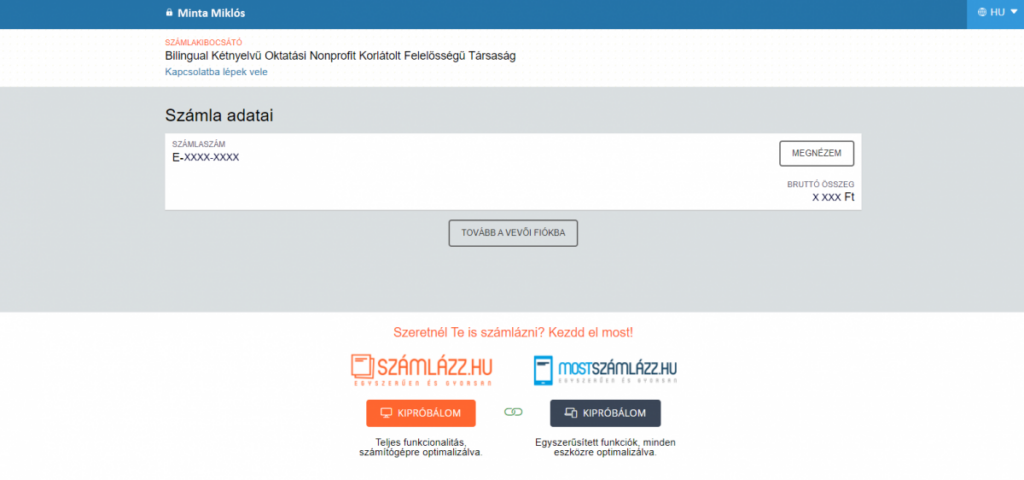
In both cases, clicking on the middle button will take you to the customer account:
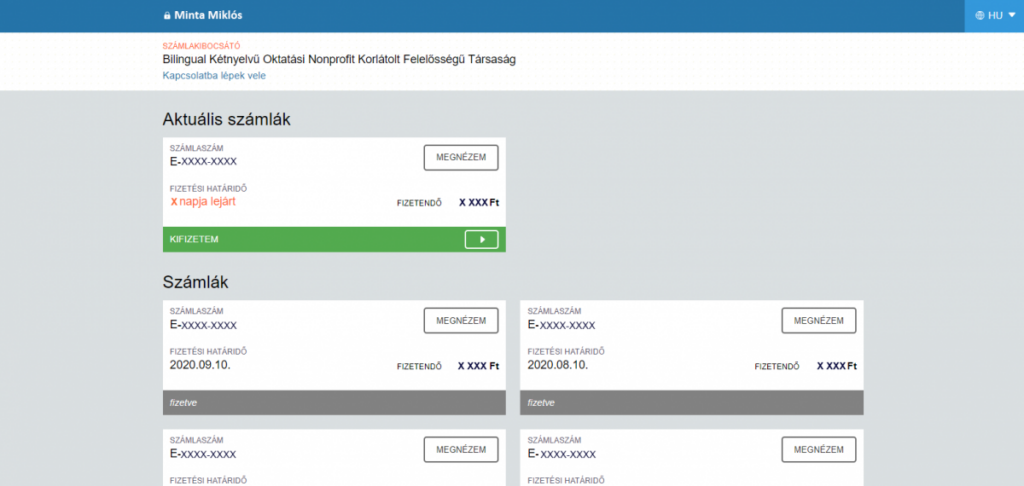
The customer account includes all invoices issued to the cost bearer, according to the current financial situation.
Below the main invoice data, in the bottom line, you can see if the invoice has been paid (in the black bar, in the case of a settled invoice), and in the green bar, you will see “Pay now” (Kifizetem ) for financially open invoices.
The financial settlement of the invoices in the invoice account will be processed immediately upon receipt of the bank statement, which in practice means that the item must be included in the paid invoices on the day following the transfer of the invoice.
If you have questions or disagree with the register, you can email our colleague at Bilingual Kétnyelvű Oktatási Nonprofit Kft. (name of the account issuer).
by clicking on the “contact ” (kapcsolatba lépek vele ) button. After inspection our colleague will get back to you.
Why do we have to pay during the summer vacation?
As the Bilingual Program’s financial policy requires advance payment (the first payment deadline of the school year following the year in question shall be 10 June preceding the school year in question regardless of the payment frequency selected), those joining the Program must also pay during the summer period if they have selected the 12-payments-a-year plan (just as those selecting other payment frequencies also pay for the summer months).
Our Service Fee applies for one school year and may be paid through two types of arrangements:
– payment in installments (spreading the annual tuition over 12, 10 or 4 installments)
– advance payment discount (if the annual tuition is paid in a single sum or in two parts)
“We were only enrolled in school in September, but there are several months on the first bill, not just the September tuition.”
For those joining in the summer or early September after the enrollment period (in kindergartens and primary schools, enrollment ends usually in mid-April,):
If you choose to pay 12 times a year, we issue an invoice each month, including the summer months. The invoice for the first Service Fee of the school year is the Service Fee for July, with a deadline of 10 June, and the invoice for the last fee of the school year is for the June fee, with a payment deadline of 10 May. That payment arrangement is adjusted to the accounting year of Bilingual Nonprofit Kft, lasting from 1 July to 30 June of the following year.
Each month started counts as a full month for service fee payment. “The time unit for prorated settlement is a school month.” (GTC 53)
Thus, if your child starts their studies in the Bilingual Program on September 20, the first invoice will include the Service Fee for July, August, September, October (since the October fee must be paid by the September 10 payment deadline). Then we will issue an invoice every month; the last invoice for the school year will be the June invoice issued with the payment deadline of May 10th. This is how the 12 times work out.
When can a contract be paused?
In the course of education, the Service Provider cooperates closely with the partner institutions (GTC 17). It is only possible to pause if the child does not continue their studies at the Partner Institution but intends to return (eg due to the parents’ employment abroad).
How do I report changes?
You can initiate the updating of your data and changes related to your contract on this form:
“Changes related to the parents contract” here: https://bilingual.hu/en/downloads
Please note that notifications received through this form into our system are official, emails sent instead cannot be accepted.
Can the Bilingual Program Service Fee be charged or used at Cafeteria?
According to the resolution sent by NAV to our company:
“It does not qualify as a pre-school service, so it is not a tax-free English education provided by a business company in preparation for school education.”
“Only the payment of the service provided by the kindergarten (day care, day care according to age, care, education, employment) can be granted tax-free.”
Thus, the kindergarten reimburses the meals to the maintainer, the local government, therefore there is no such item in the Service Fee of the Bilingual Program.
Accordingly: GTC. Point 44.:”The Cost Bearer acknowledges that Provider cannot issue a tax certificate relating to the Fee. Provider informs Cost Bearer that kindergarten services in question do not qualify as statutory kindergarten provision, thus they cannot be deducted tax free.
It is clear from the parental contract that this is a Service Fee paid for the child’s English language development, so it is not an eligible cost for the company even in the case of the company. This item is not acceptable (and may result in a penalty) for eligible costs during a possible tax audit
Therefore, for the reasons detailed above, there is no possibility to amend the contract or to issue an individual invoice (with the name of an individual item).
The rules related to invoicing are set out in Articles 44-55 of the General Terms and Conditions. You can view the full text of the GTC itt HERE.